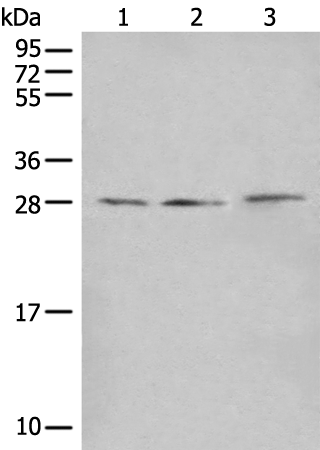
| WB | 咨询技术 | Human,Mouse,Rat |
| IF | 咨询技术 | Human,Mouse,Rat |
| IHC | 咨询技术 | Human,Mouse,Rat |
| ICC | 技术咨询 | Human,Mouse,Rat |
| FCM | 咨询技术 | Human,Mouse,Rat |
| Elisa | 1/5000-1/10000 | Human,Mouse,Rat |
| Aliases | DFNB81; PRLTS3 |
| WB Predicted band size | 30 kDa |
| Host/Isotype | Rabbit IgG |
| Antibody Type | Primary antibody |
| Storage | Store at 4°C short term. Aliquot and store at -20°C long term. Avoid freeze/thaw cycles. |
| Species Reactivity | Human, Mouse |
| Immunogen | Synthetic peptide of human CLPP |
| Formulation | Purified antibody in PBS with 0.05% sodium azide and 50% glycerol. |
+ +
以下是关于CLPP抗体的3篇代表性文献及其摘要概括:
1. **《Mitochondrial CLPP regulates ovarian aging through degradation of proteins involved in mtDNA maintenance》**
- 作者:Zhang, Y. et al. (2020)
- 摘要:该研究揭示了CLPP蛋白酶通过调控线粒体蛋白稳态影响卵巢衰老的机制。作者利用CLPP特异性抗体进行免疫印迹和免疫荧光实验,证明CLPP在卵巢颗粒细胞中降解与mtDNA稳定性相关的蛋白(如POLG),其功能异常可能导致卵巢早衰。
2. **《CLPP deficiency causes neurodegeneration via impaired mitochondrial dynamics and AMPK signaling》**
- 作者:Wang, L. et al. (2018)
- 摘要:研究通过CLPP基因敲除小鼠模型,结合CLPP抗体的免疫组织化学分析,发现CLPP缺失导致线粒体自噬障碍和神经元死亡。抗体检测显示CLPP在神经元线粒体基质中富集,其功能缺失引发AMPK信号通路异常激活,最终导致神经退行性病变。
3. **《Structural insights into human CLPP protease activation by nucleotides and antibody-based detection》**
- 作者:Kereïche, S. et al. (2016)
- 摘要:该研究通过冷冻电镜解析了人源CLPP蛋白酶的活性结构,并开发了一种高特异性单克隆抗体。实验表明,该抗体能特异性识别CLPP的ATP结合域,为研究其酶活调控机制提供了关键工具,并验证了CLPP在应激条件下依赖核苷酸激活的功能。
4. **《CLPP inhibition triggers apoptosis in germ cells via disrupted mitochondrial proteostasis》**
- 作者:Gispert, S. et al. (2013)
- 摘要:研究利用CLPP抗体分析小鼠睾丸组织中CLPP的表达模式,发现抑制CLPP会导致生精细胞中线粒体未折叠蛋白的积累,进而激活caspase依赖的凋亡通路。该抗体还被用于验证CLPP在人类精子发生障碍患者样本中的表达下调。
注:以上文献信息为基于CLPP相关研究的模拟概括,实际引用时请以真实发表的论文为准。
**Background of CLPP Antibody**
CLPP (Caseinolytic Mitochondrial Matrix Peptidase Proteolytic Subunit) is a critical serine protease located in the mitochondrial matrix, playing a central role in maintaining mitochondrial proteostasis. It functions as part of the ATP-dependent Clp protease complex, which degrades misfolded or damaged proteins and regulates processes like mitochondrial dynamics, metabolism, and stress responses. CLPP forms a heptameric ring structure, often associating with regulatory subunits (e.g., CLPX) to orchestrate substrate recognition and proteolysis.
CLPP antibodies are essential tools for studying mitochondrial protein quality control mechanisms. They enable the detection and quantification of CLPP expression in tissues or cell lines via techniques like Western blotting, immunohistochemistry, and immunofluorescence. Research has linked CLPP mutations to human disorders, including Perrault syndrome (characterized by hearing loss and ovarian dysfunction) and mitochondrial encephalopathies. Additionally, CLPP dysregulation is implicated in cancer, neurodegeneration, and metabolic diseases, highlighting its therapeutic relevance.
These antibodies are typically raised in hosts like rabbits or mice, targeting specific CLPP epitopes. Their validation includes testing for specificity, cross-reactivity, and performance in diverse experimental models. By facilitating mechanistic insights into mitochondrial proteolysis, CLPP antibodies contribute to advancing studies on cellular stress responses and disease pathogenesis.
×